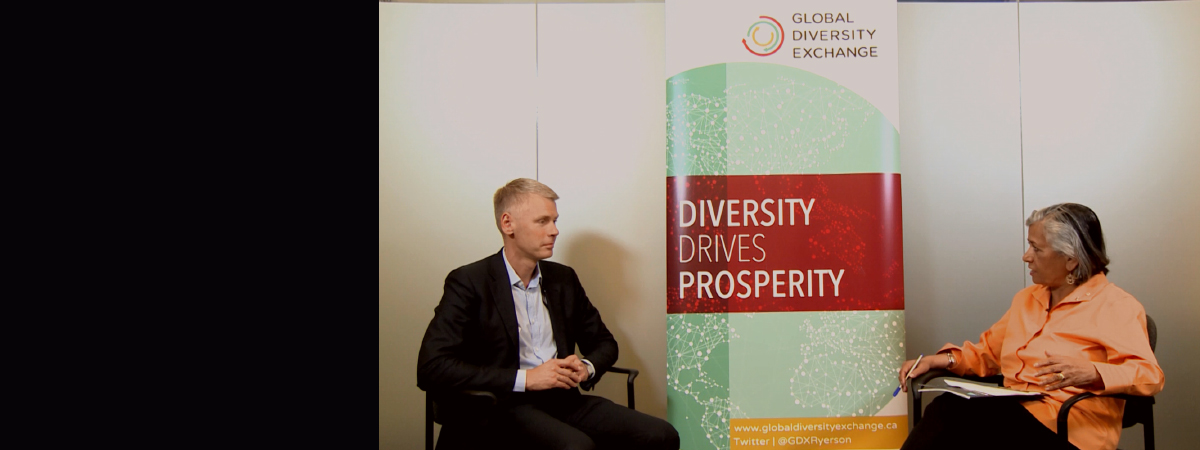


The second annual assessment of the world’s leading authorities on diversity was announced on Tuesday, November 29, 2016, and for the second year running both the Global Diversity Exchange and GDX founding Executive Director Sen. Ratna Omidvar were recognized for their efforts.
The Global Diversity List is a comprehensive guide to organizations and individuals who are at the forefront of promoting diversity in human resources policy and practice. The list is supported by the Daily Telegraph newspaper in the UK, and founding partners include such global giants as AT Kearney, Barclays, BNP Paribas, KPMG, Societe Generale, Standard Chartered, UBS, and WorldPay.
- GDX was recognized as a Top 10 Ethnicity Employee Network. This category recognizes the achievements of employee network groups established to work on race diversity within organisations.
- Sen. Ratna Omidvar was recognized as a Top 50 Diversity Figure in Public Life. This category recognizes the achievements of individuals who have used their position in public life, for example as a campaigner, politician or journalist, to make an impact in diversity.
For more information about the 2016 Global Diversity List, visit their website.
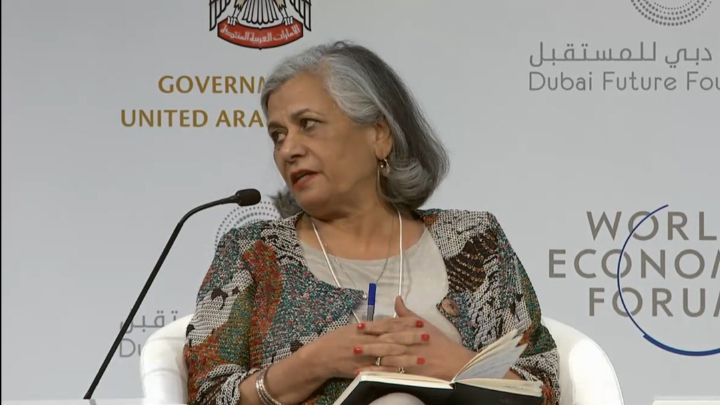
At the World Economic Forum’s brain-storming meeting in Dubai on November 13, 2016, Senator Ratna Omidvar joined Ngaire Woods (Dean, Blavatnik School of Government, University of Oxford), Gemma Mortensen (Chief Global Officer, Change.org), Peter Maurer (President, International Committee of the Red Cross), Majid Jafar (Chief Executive Officer, Crescent Petroleum), and moderator Hadley Gamble (Reporter and Anchor, CNBC) to discuss how leaders can exercise responsive and responsible leadership that is forward-looking in the face of prolonged crisis and vulnerability.
Source: www.weforum.org
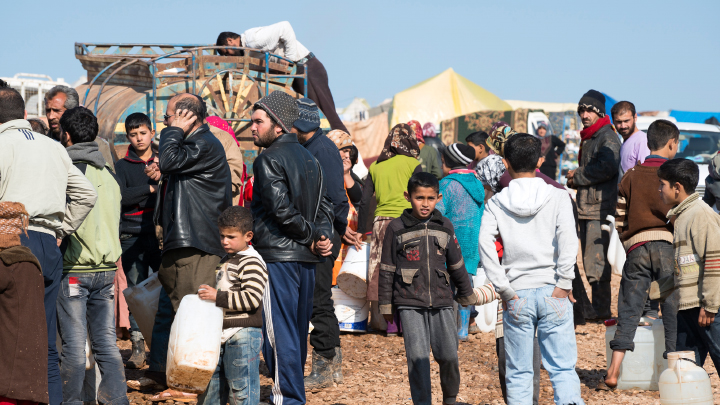
By Senator Ratna Omidvar, Founder, Global Diversity Exchange
This article was originally published on the World Economic Forum website.
In the management of global migration, the world is clinging to outdated infrastructure and patterns of mobility, says Canadian senator Ratna Omidvar, member of the Global Future Council on Migration. The contribution immigrants make to their host communities is not widely understood, and countries need to begin showing an interest in all migrants, not just skilled labour.
How do you see the state of migration today?
In the management of global migration, we are clinging to outdated infrastructure and patterns of mobility. We operate reactively instead of planning for the future.
I look back at the major migration trends of the last decade, and I wonder what could be different had we been prepared. The last decade gave us the largest number of displaced people since the Second World War, a steadily rising death toll in the Mediterranean, populist politics that traded on fear of immigration, and new environmental factors driving people from their homes. With the clarity of hindsight, planning for these realities could have strengthened the wellbeing of host communities, supported immigrants to move and prosper, and even saved lives.
Which issues related to migration do you perceive to be misunderstood or inadequately appreciated?
The evidence of the contributions immigrants can make to their host communities is not widely understood or accepted. This is true of both camps: those who think immigration is bad, and those who think it is good. The impact of immigration on communities is nuanced, and in many studies we see evidence of different outcomes due to different policy and social contexts. Robert Putnam found evidence of ebbing trust leading people to “hunker down” in diverse American communities, while Keith Banting found the opposite effect in equally diverse Canadian communities, where trust and engagement bloomed alongside immigration.
Sometimes, perception and reality are at odds. For example, a community or country may demonstrate positive gains from immigration but public opinion stubbornly disagrees. Where these contradictions persist, it is important to think about how to change perceptions.
What will be the most significant migration issues over the next 10 years?
One is the integration of displaced populations. Over 65 million people are currently displaced. The majority – 54% or 35 million – come from Somalia, Afghanistan and Syria. Their displacement will be long-term. They are in need of the basics of survival, employment opportunities, services, and community. Planning for integration instead of displacement means a shift from building temporary solutions to permanent infrastructure.
A second is tackling inequality in destination communities. Dissatisfaction at home and disillusionment with globalisation is a driving political force behind the recent rejectionist movement in countries that have swung towards closed-border nationalism. Inequality that builds a “marginalized majority” of native citizens boosts the power of anti-immigration narratives.
A third significant issue is preparing cities for ecological migration. The changing climate is causing people to move in mass and sometimes invisible numbers. City planners have not kept pace and internal migrants especially in the Global South are landing in slums and informal housing. As thinkers like Katherine Boo and Doug Saunders have documented, the fortunes of those who land in slums depend on policies that keep them in or help them out. Will these increasingly populated places of arrival become permanent homes, or temporary launch pads?
Fourth, planning for new patterns of resettlement should be a high priority. It is becoming clear that resettlement models in traditional destination countries like Canada, Australia and parts of Europe are in need of a refresh. They were built for cities not yet transformed by the defining socio-economic trends of the past decades: the growth of informal jobs, and the passage of poverty from inner cities to suburbs. Urban planning for integration means changing the physical centres of gravity in settlement.
What do you think the Global Future Council on Migration can contribute to the global effort to help migrants?
Given the diversity of members and contributors, I believe the Council on Migration has a major role in framing the conversation, and injecting facts and evidence into the political conversations that tend towards emotional arguments. I hope that we can deepen public understanding of the benefits of migration, diversity and inclusion. We must do this soberly: migration is not a silver bullet to our problems, but it can lead to shared prosperity for migrants and for host communities under the right conditions.
Using our diversity, we can also find the global good practices that can be replicated in other jurisdictions, such as Germany’s upskilling for refugees in universities and the trades, or Canada’s private sponsorship of refugees programme.
What more needs to be done for migrants?
It’s incredible to imagine that, because of visa restrictions, people are willing to risk their lives to find safety and opportunity. They will pay ten times what a legal trip on an airplane would cost, huge sums of money, to make dangerous overland trips or flee on unsafe boats. This is because we are intentionally making it difficult for people to migrate. We need more channels of safe, legal migration.
Regarding refugees in particular, resettlement commitments need to be honoured and raised. Countries taking part in the leader’s summit in New York in September committed to roughly doubling the number of refugees they collectively admit through resettlement or other third country admission programmes to more than 360,000 refugees. This is a significant number, but it amounts to under 2% of the 21.3 million refugees registered with the UN.
What do you think the migration situation will be by 2030?
Unless we fix issues of global governance, migration risks tearing the EU apart. We are going to see the hardening of attitudes in certain regions because they don’t see the opportunity in migration. Part of that comes from the fact that people only see migration as a good thing when we think of the highly skilled. But highly skilled people are more likely to come, settle, and then get recruited elsewhere. The long-term solution is to give a hand out to people now. The payoff is that their children will succeed, and those children will build the next generation of lawyers, doctors and create prosperity in those countries.
In Canada, we have taken that approach. Once people get here, after a rigorous screening process, we throw the government behind them. We educate and upskill them where needed, teach them the national languages, help them get jobs and integrate into society. Finally, we put them on the path to citizenship.
Global migration will continue to become even more normalised. There will be leading countries that realise long-term solutions for integration helps natives and newcomers to prosper. There will be problems along the way, but I think we might be quite surprised by what happens next. We might see countries not currently on the map stepping up and becoming big players.
What would be your ideal migration scenario in 2030?
By that time, I hope that displaced people worldwide are considered a mainstream source for immigration to countries in need of economic and population growth. There are over 65 million displaced people, and yet advanced and emerging economies alike are struggling with labour shortages.
Second, I would like to see a global governance system that qualifies people professionally. One hurdle that still remains for migrants is coming to a new country where their qualifications are not recognised. On top of this type of structural barrier, we know that immigrants face discrimination and bias, which impacts their work and wellbeing. By 2030, I want people who move from one city to another and not worry about the colour of their skin or the barriers to requalify in their field of training. They will worry about what someone who moves from Toronto to Ottawa worries about: the restaurants, the rent, the weather.
The Annual Meeting of the Global Future Councils is taking place on 13-14 November in Dubai.
Source: www.weforum.org

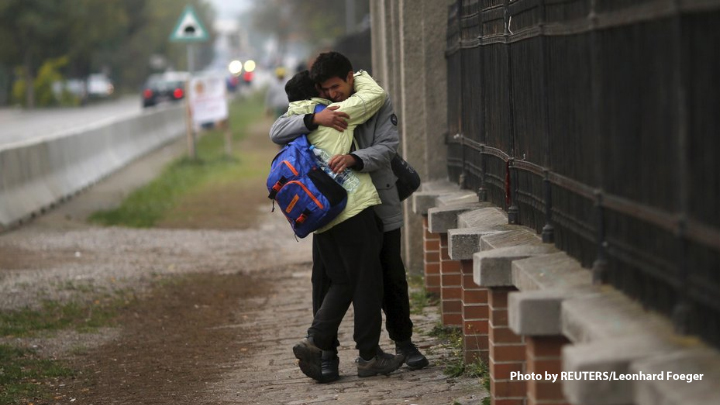
How can we create more welcoming and compassionate societies? One policy at a time. Here are nine initiatives to better promote inclusion, from a cross-section of speakers at this week’s 6 Degrees forum.
By Kamal Al-Solaylee, Mathieu Lefevre, Luis Larrain, Ratna Omidvar, Richard van der Laken, Bessma Momani, Pete Sweetnam, Madeleine Redfern, and Naheed Nenshi
This article originally appeared as part of OpenCanada.org’s series Finding Home: An exploration of inclusive societies, as part of the 2016 6 Degrees event.
1. Inspire an entire generation with a single book.
— Kamal Al-Solaylee, Canadian journalism professor and author
Late last December, the Swedish Women’s Lobby announced plans to give a free copy of Nigerian novelist Chimamanda Ngozi Adichie’s short book We Should All Be Feminists to every 16-year-old in Sweden. The news stuck with me ever since. The more I thought about it, the more I admired the thinking behind a policy in which an author, her publisher and a community of women’s groups managed to amplify the message and contributions of feminism to public life through the power of books.
But it was the choice of Adichie that I found particularly inspired. As a black, Nigerian author who has written about the multiple experiences of living in Africa (and outside it) in such award-winning books as Half of a Yellow Sun and Americanah, Adichie blends gender and race issues and refuses to see one independent of the other. It’s vital for all of us who write about or work on issues of inclusion and diversity to get off the one-struggle, each-to-his-own high horses. It’s impossible to separate problems arising from gender inequality, even in a liberal democracy like Sweden, from wider discussions of race and global migration. About 16 percent of Sweden’s population was born elsewhere, and waves of migration continue — in 2015, 163,000 displaced individuals applied to Sweden for asylum — against a growing chorus of disapproval and xenophobia. In introducing young Swedes to the importance of feminism, Adichie’s book doubles as a gateway into a world outside their Scandinavian comfort zone.
I also love the idea of giving away a single book to an entire generation. We live in a world where cultural touchstones are all too rare — there’s simply too much of everything and very little stands out anymore. Giving a generation a common vocabulary around gender rights ensures that they will all be on the same page —literally — but, more importantly, emotionally and politically. Books can do that.
Kamal Al-Solaylee is a journalism professor at Ryerson University in Toronto and the author of the national bestsellers Intolerable: A Memoir of Extremes and Brown: What Being Brown in the World Today Means (to Everyone).
2. Let them eat tofu.
— Mathieu Lefevre, creator of new venture, Plus 1
The shocking Burkini ban imposed by some mayors in France (and later annulled by France’s highest court) is only the latest in a series of clashes around the place of Islam in modern France and the interpretation of secularism (“laïcité”). France, rocked by horrendous terrorist attacks and with the National Front on the rise, is a tense place right now.
Food has long been a battleground in this debate. In 2015 the mayor of Chalon-sur-Saone, a town of about 45,000 people, passed a rule banning alternatives to pork in school cafeterias. He invoked the principle of “vivre ensemble” (living together), arguing that offering different menus on religious grounds was a form of discrimination. Typically, such measures are backed by a strange coalition of secularists on the left and the centre-right, and anti-immigrant groups. Muslim groups appealed, arguing that the proposal targets them directly. They lost. The court ruled that the mayor was providing the children with the required public service (i.e. safe, varied and nutritious food). Muslims and liberals opposed to the ban were furious.
Having a calm debate on French identity and the place of religion (that is code for Islam in today’s France) is essential, but appears impossible in the short term. Yet pragmatic solutions to questions like serving alternatives to pork in schools need to be found.
Just such a way out of the school meal crisis is gaining ground: the vegetarian option. Schools could offer a healthy, environmentally friendly and widely acceptable vegetarian alternative to all types of meat, including pork. This would be served everyday, not just on days where pork is on the menu.
Over 150,000 people signed a petition on Change.org in favour of the vegetarian option and a bill is being sent to Parliament. Local experiments in Saint Etienne and Perpignan have been successful. The City of Paris should test this: with 30 million school meals served annually, the political and environmental impact would be significant.
Mathieu Lefevre is currently reinventing French and European dreams with Plus 1. Formerly with New Cities Foundation and World Bank.
3. Push harder on same-sex marriage.
— Luis Larrain, Chilean activist
Regarding the LGBT community, equal marriage is a great way to promote inclusion for several reasons.
First, because it is possible: it has been already implemented in over 20 countries, including Canada, and it is being discussed in several others, including my homeland, Chile. Second, because it is very efficient, as it doesn’t need a lot of taxpayers’ money to be implemented. Additionally, its scope is much broader than expected, as it doesn’t only benefit the couples who are getting married but also their families and friends, who are happy to see how their loved ones are included in society; the whole national LGBT community, as they live now in a place where the state tells them that being gay or lesbian is as valid as being straight; and the whole of society, as all its members live now in a place where diversity is considered a value and not a problem, and where minorities’ rights are respected.
I hope the rest of the world realizes one day that culture shouldn’t serve as an excuse to deny people their fundamental rights, regardless of their sexual orientation, race, gender, religion or any other characteristic.
Luis Larrain is an activist based in Santiago, Chile. He is co-founder of Fundación Iguales, the largest LBTGI organization in the country.
4. Increase diversity in boardrooms.
— Ratna Omidvar, Canadian Senator
Pluralism in leadership is but one of many ways to embed effective diversity and inclusion into our everyday communities. We’ve heard it before: our communities are diverse, why isn’t our leadership? Pluralistic leadership at the top reflects a truly inclusive and diverse community where society demonstrates openness, receptivity and acceptance to a wide range of thoughts, peoples and ideas.
Initiatives like DiverseCity onBoard and organizations like the Canadian Board Diversity Council (CBDC) build leadership capacity and focus on pluralistic leadership in Canadian institutions. DiverseCity onBoard’s mandate is to increase diversity on the boards of not-for-profit organizations and public agencies across the nation; CBDC measures and promotes the progress of Canada’s largest corporate boards in diversifying their leadership. These initiatives are key to achieving truly inclusive and diverse communities by developing and investing in plural leadership.
Civil society efforts are even more effective when paired with public policy. Prime Minister Justin Trudeau made international headlines with his reply when asked about gender parity in his cabinet: “Because it’s 2015.” But we can do better. The next step is to expand these policy levers to underscore the need for diverse leadership not solely in terms of gender or ethnicity, but across all facets of diversity.
Ultimately, the key to making a difference lies in a change in leadership. Making room at the top for diversity is in the hands of those who are now there, and they can begin to make room for diversity by looking for, including and listening to people who are not like themselves. Ordinary Canadians from underrepresented groups can then sign on to make a difference in our communities. And our public and corporate institutions must appoint truly diverse leadership so that our communities can benefit from effective inclusivity that generates innovative ideas and actions, and makes pluralistic leadership the norm at all levels of society.
Ratna Omidvar is a member of the Senate of Canada, and an internationally recognized expert on migration, diversity and inclusion. She is the founding Executive Director of the Global Diversity Exchange at Ryerson University, Toronto.
5. Reframe refugees through photography.
— Richard van der Laken, What Design Can Do
The fact that the humanitarian crisis is so pressing means that media channels, NGOs, pressure groups, governments and others constantly seek images that represent those affected.
The digital platform Reframe Refugees — presented as part of the What Design Can Do Refugee Challenge 2016 — taps in to the demand for images and creates a service provided by refugees and for the benefit of refugees.
Reframe is a photo-based platform where refugees, 90 percent of whom carry a smartphone, can share their side of the story and show us what they want us to see. Their uploaded photos, with personal descriptions, are quality checked and then offered for purchase by media companies. Payment takes the form of a donation to a charity that aids the refugee cause, chosen by the buyer.
The concept of reframing public narratives through refugee photography is powerful, challenging to achieve and do well, but definitely worth prototyping.
Richard van der Laken is a graphic designer and entrepreneur from the Netherlands. He runs What Design Can Do, a global project that seeks design responses to humanitarian crises.
6. Implement blind recruitment.
— Bessma Momani, CIGI senior fellow
Canada would be well served to follow “blind recruitment,” where names are removed from job applications in both the private and public sector until after interviews are confirmed.
This has been proven to help fight against racism and unconscious bias of employers. This has already been adopted in the public sector of the United Kingdom and one Canadian MP, Ahmed Hussen, has proposed this for Canada. Simply put, most of our government institutions and halls of decision-making are still lacking visible minorities, despite the fact that ethnocultural communities are now increasingly as or more educated than their counterparts and are a sizeable part of our society.
There is discrimination in our public and private sector and this small step toward ensuring a level playing field can be of immense benefit.
Finally, the Toronto Symphony Orchestra started its blind auditions, where performers were not visible to others as they played their instruments. This has helped the TSO now become a far more diverse symphony thanks to ensuring that the most talented individual is playing and not the person with the easiest name to pronounce.
Bessma Momani is an Associate Professor at the University of Waterloo’s Balsillie School of International Affairs and a senior fellow at the Centre for International Governance and Innovation.
7. Provide humanitarian flights.
— Pete Sweetnam, Director, Migrant Offshore Aid Station (MOAS)
Two years ago, MOAS (Migrant Offshore Aid Station) was founded as a disaster relief organization in response to the deadly consequences of the migration crisis in the Mediterranean Sea. Two years on, we are still dealing with those same consequences. Not only that, but the needless loss of life in the Mediterranean has only increased as a lack of alternatives are forcing asylum seekers further into the hands of smugglers, who take them on ever more dangerous routes, both on land and at sea. The horrors our search-and-rescue crews have borne witness to have only served to reinforce our belief that ‘No One Deserves to Die at Sea,’ but we are also aware that our work is not the solution to the problem. Our efforts at sea are merely a stop-gap since sustainable solutions have yet to be established.
With our experience on the frontlines of the most devastating humanitarian catastrophe of our generation, MOAS is calling for a radical rethink of the global migration crisis through the creation of humanitarian flights — a visionary policy that addresses the missing link in the EU’s asylum policy by granting a group of asylum seekers trapped in Libya legal entry to Europe — from countries of transit where the living conditions for asylum seekers are deteriorating and access to basic human rights, particularly protection, are lacking. Humanitarian flights are the only sustainable and long-term solution for the ongoing and unprecedented mass movement of people, which history has clearly demonstrated will not and cannot be stopped by building walls, hiding behind razor wire or militarizing the sea.
Pete Sweetnam is the Executive Director of the Migrant Offshore Aid Station (MOAS). He has been involved in development and relief sectors for over 30 years.
8. Support Nunavut’s Article 23.
— Madeleine Redfern, Mayor of Iqaluit
In Nunavut, Inuit have always been the majority ethnic group in the region and, as they have for the past 20-plus years, make up 85 percent of the territory’s population. As in many other Indigenous regions, Nunavut Inuit have a modern-day land claims agreement, similar to treaties.
In our claims agreement, Article 23 attempts to increase Inuit inclusion in the government workforce, which is the primary employer in the territory. The reason behind Article 23 is to ameliorate the historical problem of Inuit not being hired and therefore being under represented even in the public institutions that are set up to serve them.
While some non-Inuit have criticized Article 23 for its priority or preferential hiring as discriminatory, the law permits government to address systemic discrimination that has resulted in under representation of minorities. Fundamentally, democratic societies understand that their public institutions should and need to reflect the people that they serve and that is the basis behind Article 23. The north has long been governed and managed by a non-Indigenous minority over the Indigenous majority.
Article 23 obligates the government, whether local, territorial or federal within Nunavut, to increase the number of Inuit within its bureaucracies to proportional representation levels. This means that each level of government should ideally have 85 percent Inuit within each of its respective public institutions. Furthermore, not just 85 percent at the entry or lower levels but 85 percent throughout, in all sectors and all professions.
Before 1999, the Government of Northwest Territories employed approximately 50 percent Inuit in the Eastern portion of the territory (what would become Nunavut) and in 2015, the Government of Nunavut employed approximately 50 percent Inuit. The number of government jobs has increased but proportionally Inuit remain significantly under represented. In 2006, Nunavut Tunngavik Inc. (NTI) sued the Government of Canada for failing to fulfill its land clams obligations, including specifically failing to increase the number of Inuit in government. NTI and the Government of Canada settled the lawsuit in 2015 with the Government of Canada paying NTI $225.5 million ($175 million for initiatives to provide Inuit with skills and qualifications needed for employment). The federal government is also giving the Government of Nunavut an additional $50 million over eight years to fund training initiatives and programs to enhance Inuit employment and fulfill its obligations under Article 23.
There is recognition that the biggest hurdle for government in hiring and increasing Inuit employment within its institutions is the lack of Inuit with sufficient education, skills and experience. Therefore, the goal for this settlement money is to wisely invest it and thereby give more Inuit the opportunity to gain the requisite capabilities necessary to compete and secure employment, fulfilling their individual aspirations and achieving the original spirit and intent of the land claims agreement, which is to see Inuit governing and managing all aspects of democratic governance. This would create a distinctly unique Inuit territory within Canada based on democratic principles that promote Inuit political and societal aspirations, while respecting the rights of non-Inuit and the multiculturalism of Canada.
Madeleine Redfern is the Mayor of Iqaluit. She has 25 years of experience working on housing, education, employment, business, economic development and governance.
9. Promote the three Ps: policy, programs and people.
— Naheed Nenshi, Mayor of Calgary
We are blessed to live in a country where the concept of pluralism is often considered one of our core values. And when that concept is challenged, as we saw during the last federal election, the majority of Canadians will step forward to defend it. Our response to Syrian refugees is a good example — as that crisis unfolded and Canadians learned more about the role we could play, the most common question (and dare I say most “Canadian” of questions) was: how can I help?
It’s helpful to consider the state of pluralism in Canada through the frame of 3Ps (Policy, Programs and People) and how they work together. The right application of all three can yield the most impressive results. For example, we’ve learned that, when it comes to building community, the most effective government policies enable local action. While the federal government may create the policy and NGOs craft the programs, it’s ultimately the people who make it all work. With resources and encouragement, Canadians do amazing things.
The result has been even better than expected: Canada has welcomed many thousands of new citizens without the doom foretold by those who struggle to imagine the pluralism we both take for granted and fight to maintain. With smart policy enabling the best of ourselves, we’ve made Canada and the world an even better place.
Naheed Nenshi is the Mayor of Calgary. He was Canada’s first tenured professor in the field of nonprofit management at Mount Royal University’s Bissett School of Business and a former business advisor.
Source: OpenCanada.org
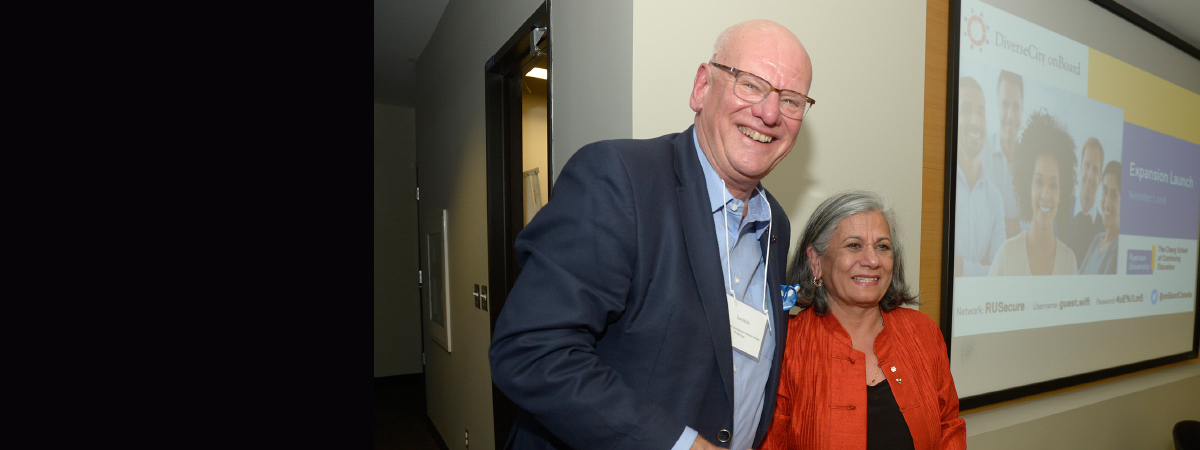

$500,000 gift from TD allows expansion of board-matching program DiverseCity onBoard at Ryerson’s G. Raymond Chang School of Continuing Education
This article was originally published at Ryerson University News & Events.
Ryerson University is pleased to announce a $500,000 gift from TD to expand the reach and programming of DiverseCity onBoard, an internationally-recognized program of governance training and board-matching to strengthen diversity on the boards of Canadian not-for-profit and public sector organizations. The gift was announced at a celebratory event and panel conversation held last night at Ryerson University
 The board-matching program will expand its reach to include all women and the LGBTQ+ communities. The program has formed new relationships with the Aboriginal/Indigenous community to increase their inclusion on governance boards, a representation that decreased from 1.3 per cent in 2015 to 0.6 per cent in 2016, according to the Canadian Board Diversity Council (CBDC). The CBDC reports that overall, visible minority representation on boards declined from 7.3 per cent in 2015 to 4.5 per cent in 2016. The program will expand to persons with disabilities in 2017.
The board-matching program will expand its reach to include all women and the LGBTQ+ communities. The program has formed new relationships with the Aboriginal/Indigenous community to increase their inclusion on governance boards, a representation that decreased from 1.3 per cent in 2015 to 0.6 per cent in 2016, according to the Canadian Board Diversity Council (CBDC). The CBDC reports that overall, visible minority representation on boards declined from 7.3 per cent in 2015 to 4.5 per cent in 2016. The program will expand to persons with disabilities in 2017.
“DiverseCity onBoard offered me a great platform to share my passion by giving me the opportunity to help shape the future of Canada,” says Gautam Nath, Vice-President at Balmoral Multicultural Marketing. DiverseCity onBoard helped place Nath on the board of MCIS Language Solutions, where he has served since 2010. He was recently elected Chair of the board.
The event also celebrated DiverseCity onBoard’s new affiliation with The G. Raymond Chang School of Continuing Education at Ryerson University. Senator Ratna Omidvar, Distinguished Visiting Professor and Founder of the Global Diversity Exchange (GDX), moderated a conversation between representatives from each of the groups to whom the board matching program is now open.
“Canada is one of the most diverse societies in the world, yet it needs to go further in ensuring that its leadership reflects the changing face of society. A more inclusive Canada will require new arrangements, new conversations and new voices particularly at an institutional level,” said Senator Ratna Omidvar. “I am delighted that DiverseCity onBoard, building on its success in addressing the under-representation of visible minorities and immigrant communities on governance boards, is leading this conversation by collaborating with all communities to build a more inclusive and stronger Canada.”

Sue Cummings, EVP, Human Resources, TD Bank Group
“Fostering diverse talent and leadership has long been a priority at TD as part of a broader commitment to diversity and inclusion,” says Sue Cummings, Executive Vice-President, Human Resources at TD Bank Group. “We are proud to help DiverseCity onBoard reach more people traditionally under-represented on leadership boards because we know how critical unique and diverse perspectives are to our own future growth and the growth of our communities.”
“We are delighted to welcome DiverseCity onBoard into The Chang School,” says Dr. Marie Bountrogianni, Dean of The G. Raymond Chang School of Continuing Education. “This initiative not only aligns with The Chang School’s commitment to inclusive and diverse communities, but it also presents our learners with an invaluable opportunity to bring their skills set to the board of some outstanding Canadian not-for-profit and public organizations.”
About DiverseCity onBoard
DiverseCity onBoard bridges the diversity gap in governance and raises the standard for modern governance. It is an internationally recognized program that provides self-paced, online governance training for everyone and connects qualified candidates currently under-represented in governance to boards in not-for-profit organizations and the public sector. The program operates in seven cities across Canada and has a network of over 700 organizations, and 1,800 individuals. It has facilitated the placement of over 800 appointments to governance boards. Its Founding Partners are Maytree, the TD Bank Group and the J. W. McConnell Family Foundation.
Follow DiverseCity onBoard on Twitter: @onBoardCanada
About Ryerson University’s G. Raymond Chang School of Continuing Education
With approximately 70,000 annual enrollments, The G. Raymond Chang School of Continuing Education is Canada’s leading provider of university-based adult education. The Chang School has more than 1,500 courses (over 400 courses offered through distance education), seminars, and workshops. We offer over 80 career-related certificate programs, with 20+ certificate programs that can be completed entirely at a distance. The school’s mission is to be a leader in innovative, quality, lifelong learning that empowers adults. For more info, please visit http://ce-online.ryerson.ca/ce/default.aspx
Follow The Chang School on Twitter: @ChangSchool

Source: Ryerson University
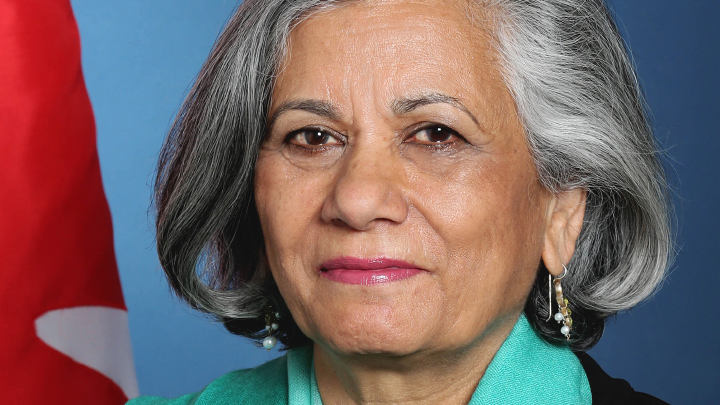
This article was originally published on SenCA Plus.
…
This article was originally published on SenCA Plus.
1. Who inspired you to get involved in public life?
Initially, public life was an accident of timing and opportunity. More precisely, it involved a lack of opportunity. I studied in India and Germany, and I arrived in Canada as a German language instructor. It was difficult finding work, and with my young daughter to care for, I had to reevaluate my professional aspirations. I began volunteering with my children’s schools, and that led to a job opportunity with St. Stephen’s Community House in Toronto. This was my first Canadian work experience as well as my entry into the non-profit sector – its remarkable work, its many frustrations, and its critical role in the lives of immigrants to Canada. My dedicated colleagues at St. Stephen’s played a large part in shaping my future path into deeper public life. A leader I would meet several years later is another personal inspiration. While his roots are in the business community, David Pecaut taught me much about organizing for public good and about involving people from all walks of life in a way that creates value for everyone.
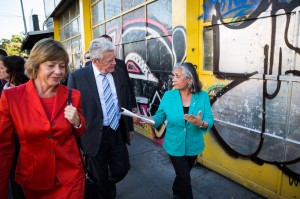
Pictured: Senator Ratna Omidvar gives German President Joachim Gauck a tour of Kensington Market in Toronto to demonstrate Canada’s success with immigration and integration.
2. What do you think are the biggest public policy issues facing Canada today?
One major issue that has ripple effects across other areas of public policy is equality of opportunity. Equal opportunity is about fairness in society, and about the ability to live a decent life and position one’s children for the same or even greater success. Without equality of opportunity, no amount of hard work can translate into a decent life. It leaves segments of the population without good options, without meaningful links to their communities, and without a sense of having a stake in public life. To take the pulse of this issue in Canada, we can look at indicators of economic and social wellbeing, such as income. Income is either not improving, or not improving at the same pace, for some groups including certain visible minority and immigrant groups, and certain First Nations communities.
3. Why should more Canadians care about what happens in the Senate?
Quite simply, Senate business is the business of all Canadians. It has real consequences, because Senate business shapes public policy, as well as public attitudes and ideas. The quality of inquiry and debate that defines the work of the Senate has made a deep impression on me since I took office in the spring. A first major piece of legislation during my early weeks was the bill on assisted dying. I heard my fellow Senators ask sincere questions of expert witnesses, voice thoughtful arguments, and propose new ideas which resulted in amendments to the law. The end result was a stronger piece of legislation, and deeper engagement by the public, government, and media on complex issues. I think Canadians would benefit greatly from increased awareness of Senate work, and we Senators can do a better job translating “sober second thought” into a public conversation.
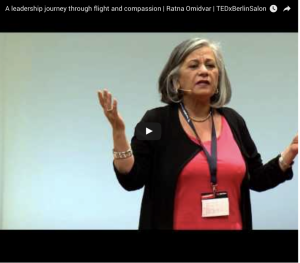
Senator Omidvar delivered a TedXTalk called “A leadership journey through flight and compassion” at TEDxBerlinSalon
4. What legislative or committee work are you most proud of participating in to date?
As a new senator, I can primarily only look forward to the work to come. But in my early days, one committee whose work I am proud to have been involved in is the Senate Committee on Human Rights. This committee undertook consultations in Montreal and Toronto to understand the quality of Syrian refugee integration, and how the federal government could better support this newcomer community. Following discussions with community stakeholders, the committee members observed several urgent areas in which the federal government could speed up the integration of Syrian refugees into Canadian society. A piece of proposed legislation I am proud of contributing towards is a bill that seeks to amend the Citizenship Act. As sponsor of the bill, I delivered a speech to give voice to the arguments in favour of the bill, which I believe will restore the equality of Canadian citizens and provide a quick, clear pathway to citizenship.
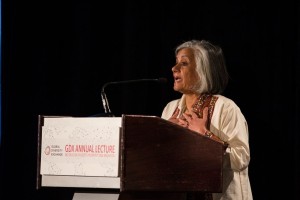
Pictured: Senator Omidvar delivers remarks at the Global Diversity Exchange Annual Lecture, which she hosted in 2015.
5. What is a hidden gem in your region that more Canadians need to know about?
I hope that everyone who visits Toronto has a chance to stroll through Kensington Market. In 2014, I had the opportunity to select one neighbourhood to showcase to German President Joachim Gauck on a stopover in Toronto to learn about Canada’s success with immigration and integration. Kensington Market was the obvious choice. It has long been an arrival neighbourhood, and then a launch pad, for wave after wave of immigrants to Toronto. Jewish, Italian, Chinese, Vietnamese, Jamaican, Somali and many other newcomers have passed through the neighbourhood and left their mark – building homes and commerce and adding layers of culture that give this central gem its modern vibrancy. Today, the neighbourhood is a delicious confection of politics, tech, arts, entrepreneurship and cuisine. The energy past is perfectly present.
6. Can you name a guilty pleasure song / album that always makes you smile and why?
Simon and Garfunkel’s Homeward Bound. When I was studying in Germany, it was my first time away from home. I was desperately homesick. My secret weapon was my favourite song at the time, Homeward Bound. To help myself cope with missing home, and to help my fledgling German, I translated the song into German and sang it over and over.
Senator Omidvar co-authored Flight and Freedom: Stories of Escape to Canada. The book recounts the stories of 30 refugees who came to Canada, and their life in this country today.
7. What is the last book you read or movie you saw which you recommended to someone else and why?
A recent film that I highly recommend is Queen of Katwe by director (and my cousin) Mira Nair. I have closely followed Mira’s work over the years, and her latest film may be one of my favourites. It tells the true story of Phiona Mutesi, a rising chess star from Kampala’s Katwe neighbourhood, portrayed by Lupita Nyong’o. It is a beautiful story of personal achievement told by a powerful cast, without any of the stale pathos or appropriated narratives that characterize so many films set in Africa.
8. What sports team (amateur/professional) do you support?
I cheer for our Canadian Olympic and Paralympic athletes. This year during the Rio Olympic Games, I discovered along with the rest of the world another team deserving the same support and encouragement we channel to our national teams: The first ever Refugee Olympic Team and Independent Paralympic Athletes Team. These athletes are from the Democratic Republic of Congo, Ethiopia, Iran, South Sudan, and Syria, but competed in Rio under the Olympic flag. Their courage, talent, and spirit should be a call to action to the rest of us. Refugees everywhere can achieve their potential if given the opportunity.
9. Why are you proud to be Canadian?
I was born into one passport, married into another, but my Canadian passport was my full choice, and the one I worked the hardest to get. This country has given me its protection and its opportunities. In return, I am committed to making it a better and better place so that it continues to be a land of protection and opportunity for future Canadians. This is why I am eternally proud to be Canadian. Not only for what Canada has given me and countless others, but because it is a work in progress. I and all Canadians can be active participants in shaping our country.
Source: SenCA Plus
